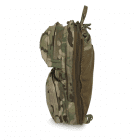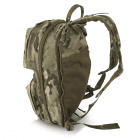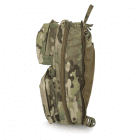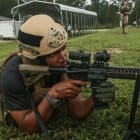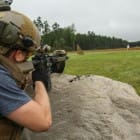In a Sources Sought Notice published on 24 September, 2018 by Product Lead, Ground Mobility Vehicles (PL GMV), they are conducting a market survey for new production of an Infantry Squad Vehicle (ISV).
According to the notice, the ISV will provide mobility for a 9-soldier infantry squad with associated equipment to move around the close battle area. The ISV is a lightweight, high mobility platform that shall be transportable by all means including vertical lift (via CH47 and UH60) and Low Velocity Air Drop (LVAD).

Polaris DAGORSome of this requirement is similar to the DAGORs used by the 82nd Abn Div and GMV 1.1 used by SOF and recently purchased by the Army for as an interim vehicle for five additional Airborne Combat Teams, but Congress has directed the Army to hold a competition for its remaining light ground mobility requirement.

GMV 1.1 manufactured by GDNeither of these vehicles will accommodate an entire nine-person Squad and equipment into. As both of these trucks satisfy the aerial delivery requirements set forth by the Army, the program is going to be tough to satisfy if the vehicle has to satisfy the large payload as well.
Additional requirements include:
Physical Characteristics: Platform characteristics will be heavily influenced by mobility, payload and by the vertical lift characteristics of the UH60 and internal transport dimensions of the CH47 as defined in MIL-HDBK-1791 and MIL-STD-1366. For purposes of this questionnaire, the ISV shall meet its transportability and aerial delivery requirements at Vehicle Curb Weight (VCW) defined as an empty vehicle with Basic Issue Items (BII), a ¾ complement of fuel, lubricants, coolant, and hydraulic fluid (as applicable). Based on current research and requirements for UH-60 Sling Load capabilities the VCW at a maximum must be 4,800 lbs. Gross Vehicle Weight (GVW) will apply to all other weight requirements. GVW is defined as VCW plus operational payload of Soldiers and their associated equipment and supplies. The GVW will be the VCW with a nine soldier payload (i.e. 3200lbs). The Gross Vehicle Weight Rating (GVWR) will be the VCW plus maximum designed payload.
Military Specific Modifications: Blackout Lights, weapon mounts, Chemical Agent Resistant Coating (CARC) paint, 24V electrical, MIL-STD-814/MIL-STD-209K provisions, North Atlantic Treaty Organization (NATO) Slave and Military Petroleum, Oils and Lubricants (POL)
Mobility: The ISV shall be a vehicle capable of traversing longitudinal grades up to 60%. The ISV shall be capable of meeting the mobility requirements from VCW to GVW on the following terrain profiles:

Survivability: The ISV is envisioned as a lightweight, highly mobile open cab vehicle. Survivability will be achieved through high mobility, a roll cage and occupant restraints.
Transportability: The ISV shall be transportable by the following means: C-17/C-130 airdrop including C-17 Dual Row Airdrop System (DRAS), C-17/C-130 internal transport in roll-on/roll-off (RORO) configuration, CH-47 internal transport, CH-47/UH-60 external transport, rail and sea.
Environmental: The ISV shall be capable of operating in Hot/Basic/Cold as defined in Army Regulation (AR)-38. The ISV shall be capable of saltwater/freshwater fording and operating in adverse environmental conditions as defined in MIL-STD-810 (e.g. blowing rain, blowing dust, salt fog, etc.).
The total number of vehicles is 2,065, procuring 100 per year, beginning in 2020.
Any potential solicitation (and resulting contract) would acquire Government Purpose Rights to associated technical data, logistical and test support, installation kits and ancillary hardware with the vehicles. The ancillary hardware includes, but is not limited to, Basic Issue Items (BII), special tools, new specialty kits, expeditionary field kits, initial support items, self-recovery winch kits, and extended draw bars.
Responses are required by Oct 26, 2018 5:00 pm Eastern. Visit www.fbo.gov for full details.












